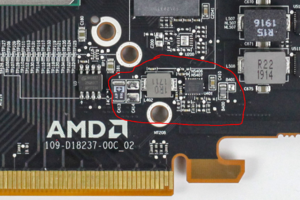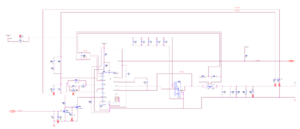More actions
| 0.75V Rail on Navi GPUs Explained | |
|---|---|
| Type | Circuit |
| Device(s) | RX 5700, RX 5700XT |
| Difficulty | ◉◉◌◌ Medium |
All about the 0.75V rail on Navi cards
The Controller Circuit
In Navi cards, you'll most likely find either a GS7260 (Full datasheet not available, used on non reference cards) or MPQ8633A buck converter (on reference cards) that steps down either 12V or 3.3V (Depending on the model) to 0.75V used only inside the core. This circuit is very similar to the 1.8V circuit.



The controller steps down 12V/3.3V on the input, from the PCI-E slot.
Enabling this controller is a power good signal coming from the 1.8V rail through a 0 ohm resistor shown in figure 3 that then goes to a dual transistor/MOSFET and then goes to the controller itself shown in figure 2.
VCC comes from 12V_BUS through a 1 Ohm resistor.
Usage
0.75V rail is used on Navi ONLY inside the core.
Its PGOOD is used to enable the VPP rail
Common Problems
Here are common problems for the 0.75V rail and possible fixes.
No voltage out on the 0.75V rail
First thing to check is the EN signal which should be 2+ V followed by VCC /VIN (Figure 2). For the MPQ, VCC should be 3.3V and VIN should be 12V/3.3V. For the GS, VCC should be 12V. if one of them is missing then check the schematic and follow the signal to find the culprit, it's usually a faulty resistor.
After making sure both of the above are there, check the FB circuit, it is possible that one or more resistors are faulty.
Short on 0.75V rail
The 0.75V has naturally low resistance (8-11 ohm) so make sure the "short" is less than 2 ohms.
To find out what is shoring 0.75V, you need to inject 0.75V through the rail and with isopropyl alcohol or thermal camera find out what is heating up. If it is not a capacitor, then the core is a high possibility(!).
Because the rail is a low voltage rail, injecting anything higher than 0.75V to it will likely kill the core. Thermal camera is recommended because of the low amount of heat generated when injecting 0.75V.
No PowerGOOD signal
PGOOD signal is pulled high through an external resistor to 3.3V. If the output voltage is normal but there is no PGOOD then you need to check that resistor (Figure 2). If the resistor is fine but the signal is held low by the controller then the controller could be faulty.
Low voltage on 0.75V rail
This usually only happens with a faulty controller or faulty resistors in the FB/COMP circuit. First check if the FB resistors are fine. If yes, then the controller is faulty.
